Adaptation European Students (Bachelor, Trade)
Adaptation of the Bachelor of Science to the European Students (second semester)
| Bachelor of Science in International Trade |

“Adaptation of the Bachelor of Science to the European Students” - Bachelor of Science in International Trade (second semester, e-learning).
The adaptation of the Bachelor of Science to the European Students consists of three parts:
- European Economic Institutions
- Introduction to the EU and their institutions
- European Single Market
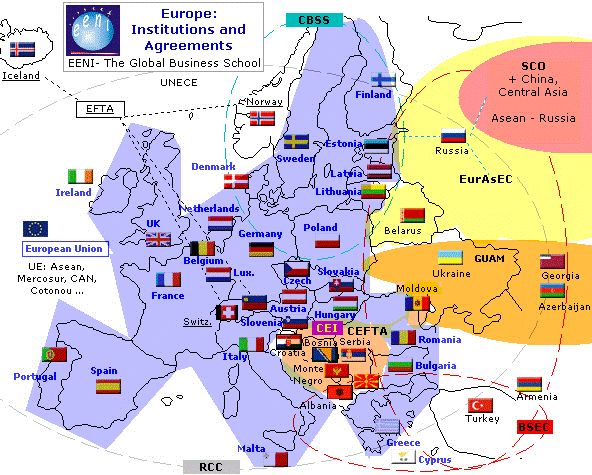
Note: Any European student, regardless of whether or not is a member of the EU, must know the basic principles of the EU, the largest single market in the world, since all the European non-EU countries maintain close trade relations with the EU.
First part: European Economic Institutions
Syllabus of the Program: United Nations Economic Commission for Europe (UNECE).
- Introduction to the Economic Commission for Europe (UNECE)
- Economic Cooperation of the Economic Commission for Europe
- UNECE Committee on International Trade
- Integration Division of the UNECE
Objectives:
- To understand the aims, functions, and institutions of the Economic Commission for Europe
- To analyze its role in cooperation, economic integration, and transport
- To know how to use the socio-economic information provided by the Economic Commission for Europe
Syllabus of the Program: Regional Cooperation Council (RCC)
- Introduction to the Regional Cooperation Council
- Functions and Organization of the Council
- European Economic and Social Development
- South-East European Cooperation Process (transport, economic, and social development)
Objectives:
- To understand the objectives and functions of the Regional Cooperation Council
- To assess the areas and cooperation processes in South-East Europe
Syllabus of the Program: Organization for Security and Cooperation in Europe (OSCE)
- Introduction to the Organization for Security and Cooperation in Europe
- The main activities of the Organization for Security and Cooperation in Europe
- Member countries of the OSCE
Second part: Introduction to the EU antheir institutions
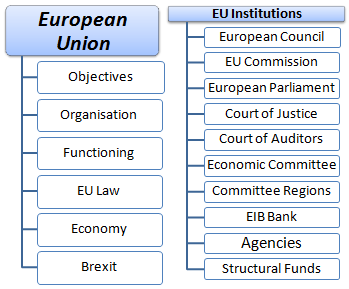
The fundamental objective of the second part is to understand the complex functioning of the EU: the largest market of the World.
Given the complexity of the EU, this part consists of two modules:
- Introduction to the EU
- EU Institutions
Subjects and objectives of the second part “Introduction to the EU and their institutions”:
Module 1- Introduction to the EU: the largest market of the World
- Objectives of the EU
- Introduction to the budget and organization of the EU
- European Union in numbers
- European Union Law
- Treaties of the EU: Roma, Maastricht, Lisbon.
- Regulations, directives and other legislative acts of the EU
- Functioning of the EU
- Introduction to the economy of the EU
- Amancio Ortega, the third richest man if the World
- Structural and Investment Funds of the EU
- BREXIT
- Working for the EU
The specific objectives of the module one “Introduction to the EU”:
- To analyze the key principles and functioning of the EU
- To understand the key concepts related to the Community law
- To evaluate the impact and causes of the BREXIT
- To understand the importance of the EU in the World
- To analyze the Structural and Investment Funds of the EU
Module 2- the EU Institutions.
- European Council
- European Commission
- European Parliament
- Court of Justice of the EU
- European Court of Auditors
- European Economic and Social Committee
- European Committee of the Regions
- European Investment Bank
- Decentralized Agencies of the EU
- European Central Bank
The specific objectives of the second part “EU Institutions” are the following:
- To know the role of the European institutions
- To understand the function of the European Council as the political arm of the EU
- To understand the priority policies of the EU
- To know the Strategic Agenda for the Union in times of change
- To understand the function of the European Commission as the executing agency of the EU
- To know the objectives, priorities and structure of the European Commission
- To understand the implications of the White Paper on the Future of Europe
- To understand the key role of the European Parliament
- To know the legislative capacity and the legislative procedures of the Parliament
- To understand the role of the Court of Justice as the guarantor of legality in the EU
- To analyze the reports, regulations and jurisprudence of the Court of Justice
- To understand the function of the European Court of Auditors as the financial supervisor of the EU
- To understand the role of the European Economic and Social Committee (EESC) as the advisory body of the EU
- To analyze the Europe 2020 multi-annual programme
- To understand the role of the Committee on the regions of the EU
- To analyze their priority policies
- To understand the areas of cooperation, objectives and strategy of the European Investment Bank
- To know the Specialized Agencies of the EU
- To understand the function of the European Central Bank in the financial and monetary stability of the EU
Syllabus of the Program: Structural and Investment Funds of the EU.
- Introduction to the Structural and Investment Funds of the EU
- European Regional Development Fund
- Cohesion Fund
- European Social Fund
- European Maritime and Fisheries Fund
- European Agricultural Fund for Rural Development
Objectives of the Program “Structural and Investment Funds of the EU”:
- To understand the function of the Structural and Investment Funds of the EU
- To evaluate the different Structural funds of the EU
Syllabus of the Program - The BREXIT
- Introduction to Brexit (UK departure from the EU)
- Economic implications of the BREXIT
- Chronology of the Brexit
- New Settlement for the UK within the EU
Objectives of the Program “The BREXIT”:
- To understand the causes of the BREXIT and their economic implications
- To analyze the BREXIT process
- To know the New Settlement for the UK in the EU
Syllabus of the Program: European Council.
- Introduction to the European Council: the political arm of the EU
- Priority policies of the EU
- Strategic Agenda for the Union in times of change of the European Council
- Conclusions of the European Council
- Summit of the Euro
- Council of the EU
- Eurogroup
Objectives of the Program “European Council”:
- To understand the function of the European Council as the political arm of the EU
- To understand the priority policies of the EU
- To know the Strategic Agenda for the Union in times of change of the European Council
Syllabus of the Program: European Commission
- Introduction to the European Commission: the executing agency of the EU
- Objectives and structure of the European Commission
- Agencies and Departments of the Commission
- Ten priorities of the Commission for 2015-2019
- White Paper on the Future of Europe: presenting avenues for unity for the EU at 27 (BREXIT)
Objectives of the Program “European Commission”:
- To understand the function of the European Commission as executing institution of the EU
- To understand the objectives and structure of the European Commission
- To know the implications of the White Paper on the Future of Europe
- To analyze the priorities of the European Commission
Syllabus of the Program: European Parliament.
- Introduction to the European Parliament
- Objectives of the European Parliament
- Legislative power of the Parliament
Objectives of the Program “European Parliament”:
- To understand the key role of the European Parliament
- To know the legislative capacity of the European Parliament
Syllabus of the Program: Court of Justice of the EU
- Introduction to Court of Justice of the EU
- Role of the Court of Justice as the guarantor of the legality in the EU
- Reports of the Court of Justice
- Key principles established by the jurisprudence of the Court of Justice
Objectives of the Program “Court of Justice”:
- To understand the role of the Court of Justice as the guarantor of the legality in the EU
- To know the reports and regulations of the Tribunal
- To analyze the key principles established by the jurisprudence of the Court of Justice of the EU
Syllabus of the Program: European Court of Auditors:
- Introduction to the European Court of Auditors
- Role of the European Court of Auditors
The objective of the Program “European Court of Auditors of the EU” is to understand the role of the European Court of Auditors as financial supervisor of the EU.
Syllabus of the Program: European Economic and Social Committee
- Introduction to the European Economic and Social Committee (EESC)
- Functions of the Committee as the advisory body of the EU
- European semester
- Europe 2020 multi-annual programme
Objectives of the Program “European Economic and Social Committee”:
- To understand the function of the European Economic and Social Committee as the advisory body of the EU
- To analyze the Europe 2020 multi-annual programme
Syllabus of the Program: European Committee of the Regions:
- Introduction to Committee on the regions of the EU
- Principles and responsibilities of the European Committee of the Regions
- The five priority policies of the European Committee of the Regions
Objectives of the Program “European Committee of the Regions”:
- To understand the function of the Committee on the regions of the EU
- To analyze the priority policies of the European Committee of the Regions
Syllabus of the Program: European Investment Bank
- Introduction to the European Investment Bank (EIB)
- Group of the European Investment Bank and the European Investment Fund
- European Investment Bank strategy:
- Countries of the EU Enlargement
- EU-Eastern neighbors
- Latin America (Iberian America)
- Asia
- Africa, the Caribbean and Pacific
- Facility for the Euro-Mediterranean Investment and Partnership
Objectives of the Program “European Investment Bank”:
- To understand the objectives and the areas of cooperation of the European Investment Bank
- To analyze the EIB strategy
- To know the European Investment Fund
Syllabus of the Program: Decentralized Agencies of the EU
- Introduction to the Decentralized Agencies of the EU
- Role of the Decentralized Agencies
- Analysis of the main Decentralized Agencies of the EU
Objectives of the Program “Decentralized Agencies of the EU”:
- To understand the function of the Decentralized Agencies of the EU
- To analyze the main characteristics of the Decentralized Agencies
Third part: European Single Market.
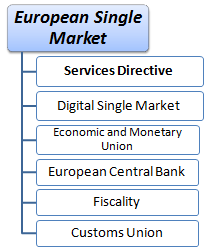
The main objective of the third part “European Single Market” is to analyze the complex functioning of the European Single Market, so that enterprises can take full advantage of the opportunities that the single market offers both to trade in products as in services.
The specific objectives:
- To understand the importance and functioning of the European Single Market
- To analyze the principles of free movement of persons, services, capitals and merchandises within the European Single Market
- To understand the Competition Policy that the EU apply within the Single Market
- To understand the importance of the Services Directive of the EU in the functioning of the Single Market and know how to take advantage of this directive
- To identify the Barriers to the trade in services in the EU
- To analyze the Electronic Commerce Directive of the EU
- To understand the concept of the European Digital Single Market
- To analyze the advantages for the EU, countries, companies and citizens of the European Digital Single Market
- To understand the fundamentals of the Economic and Monetary Union of the EU and the role of the related institutions
- To understand the role of the European Central Bank
- To understand the importance of the Eurozone
- To understand the principles of the EU Monetary Policy EU as well as the financial assistance mechanisms
- To know the functioning of the Eurozone's supervision
- To study the convergence criteria of the Eurozone
- To analyze the pillars and functioning of the European Customs Union
- To know the new Customs Code of the EU
- To know the principles of the EU Fiscal Policy, Taxation in the Single Market and general rules on VAT in the EU
Notes:
- Germany, Austria, Belgium, Bulgaria, Croatia, Cyprus, Denmark, France, Czech Republic, Estonia, Finland, Greece, Hungary, Ireland, Italy, Latvia, Lithuania, Luxembourg, Malta, Netherlands, Poland, Portugal, the UK (* BREXIT), the Czech Republic, Romania and Sweden are members of the European Single Market
- Germany, Austria, Belgium, Cyprus, Czech Republic, Estonia, Finland, France, Germany, Greece, Ireland, Italy, Latvia, Lithuania, Luxembourg, Malta, the Netherlands, and Portugal are members of the Eurozone
Syllabus of the Program: European Single Market.
- Introduction to the European Single Market
- General principles of the European Single Market
- Function of the European Parliament in the realization of the Single Market
- Free movement of workers
- Free movement of merchandises
- Freedom of establishment and freedom to provide services
- Free movement of capitals
- Competition Policy and the Single Market
- Case Study:
- Orange's acquisition of Jazztel
- TDominant position of Google according to the EU
- Company law
- Intellectual, industrial and commercial property
- Consumer Protection. The new European Union Consumer Policy
- Public procurement
- European System of Financial Supervision. Financial services
- INTRASTAT system: external trade statistics between the countries of the EU
Objectives of the Program “European Single Market”:
- To understand the functioning of the European Single Market
- To analyze the principles of free movement of persons, services, capitals and merchandises within the Single Market
- To understand the Competition Policy within the single market
Syllabus of the Program: Services Directive and the European Single Market.
- Services Directive of the European Single Market
- Existence of Barriers to the trade in services in the EU
- Simplification of administrative procedures for service providers
- Consumer Protection
- Implementation of the Services Directive
- Exceptions. Services of general economic interest
Objectives of the Program “Services Directive of the EU”:
- To understand the importance of the Services Directive of the EU in the Single Market
- To identify Technical Barriers to Trade in Services in the EU
- To know how to take advantage of this Directive
Syllabus of the Program: Digital European Single Market.
- Electronic Commerce Directive of the EU
- The EU strategy for the creation of a European Digital Single Market
- Digital Agenda for Europe
- The two pillars of the European digital single market: a free and open e-market
- Facilitating online access to products and services across the EU
- National barriers removal to online operations
Objectives of the Program “European Digital Single Market”:
- To know the Electronic Commerce Directive of the EU
- To understand the concept of the European Digital Single Market
- To analyze the advantages for the EU, countries, companies and citizens
- To evaluate the objectives and results of the European Single Market
Syllabus of the Program: Economic and Monetary Union
- Introduction to the Economic and Monetary Union of the EU
- Historical evolution of the Economic and Monetary Union
- The EU Institutions related to the Economic and Monetary Union
- ECB
- European System of Central Banks
- Economic and Financial Affairs Council (ECOFIN)
- Economic and Financial Committee
- Eurogroup
- European Monetary Policy
- Open Market Operations
- Price Stability
- Asset Acquisition Programs
- Economic governance in the Eurozone
- Coordination and supervision of the Economic Policy
- Budget Pact
- Stability and Growth Pact
- Macroeconomic Surveillance
- Macroeconomic disequilibrium procedure
- The EU Financial Assistance Mechanisms;
- European Stability Mechanism: Spain, Cyprus and Greece
- European Financial Stabilization Facility
- European Financial Stabilization Mechanism: Ireland, Portugal and Greece
- Banking Union
- Single Supervision Mechanism
- Single Resolution Mechanism
Objectives of the Program “Economic and Monetary Union of the EU”:
- To understand the fundamentals of the Economic and Monetary Union of the EU
- To analyze the functions of the five institutions related to the Economic and Monetary Union
- To understand the principles of the European Monetary Policy
- To know the functioning of the Eurozone's supervision
- To evaluate the financial assistance mechanisms of the EU
Syllabus of the Program: European Central Bank (ECB).
- Introduction to the European Central Bank
- Structure of the European Central Bank
- European Central Bank and the Economic and Monetary Union
- Eurozone
- Single Payments Area in Euros
- Convergence criteria
- Monetary stability
- Supervision of the European financial system
- Europe 2020 strategy
- Functions of the European System of Central Banks (ESCB) and the Eurosystem
Objectives of the Program “European Central Bank”:
- To understand the role of the European Central Bank in the financial and monetary stability of the EU
- To understand the Economic and Monetary Union of the EU
- To study the convergence criteria of the Eurozone
- To understand the importance of the Eurozone
- To analyze the implications for the countries of the Eurozone
Syllabus of the Program: European Customs Union.
- Introduction to the European Customs Union
- Need for the EU Customs Union
- The pillars of the European Customs Union
- Common Customs Tariff
- Customs transit
- Common customs valuation system
- Common rules of origin
- The EU product classification system
- How to classify computers and software, fruits, vegetables, footwear, plastics and textiles
- Integrated Tariff of the EU (TARIC)
- Fraud Prevention
- Value Added Tax in the EU
- Special taxes
- Customs co-operation agreements and mutual administrative assistance
- New Union Customs Code
- Introduction to new Customs Code of the EU
Objectives of the Program “European Customs Union”:
- To understand the pillars of the European Customs Union
- To analyze the functioning of the Customs Union
- To know the new Customs Code of the EU
Syllabus of the Program: Taxation in the Single Market
- Introduction to the Fiscal Policy of the EU
- Taxation in the European Single Market
- Fiscal barriers elimination
- Direct taxes: taxation of natural persons and companies
- Measures to avoid tax evasion and double taxation
- General rules on VAT. Cross-border VAT
- Cross-border dividend distributions
- Excise taxes
The objectives of the Program “Taxation in the European Single Market”:
- To understand the principles of the Fiscal Policy of the EU
- To analyze the taxation in the European Single Market
Subjects of the second semester of the Bachelor of Science in International Trade.
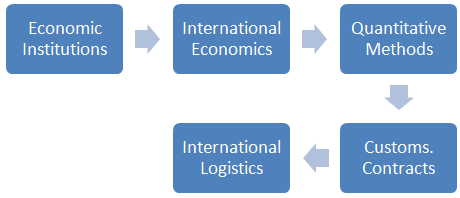
ECTS: European Transfer and Accumulation System
Samples: adaptation of the Bachelor of Science to the European Students (Bachelor of Science in International Trade, e-learning, second semester).

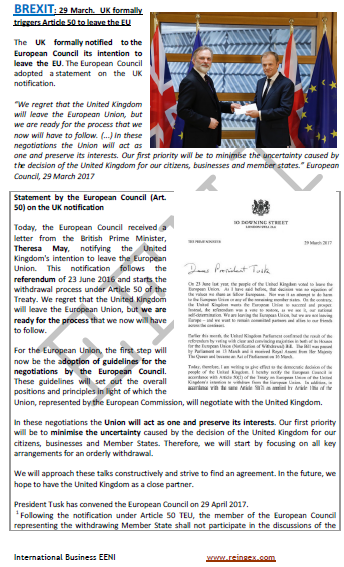
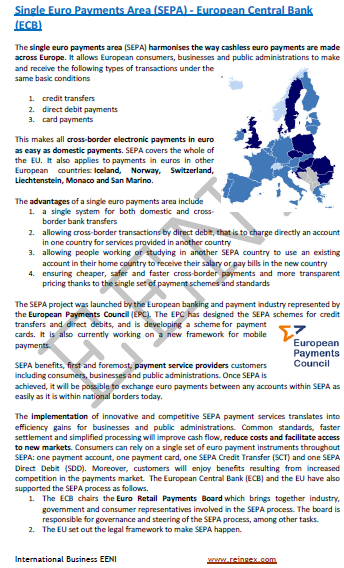

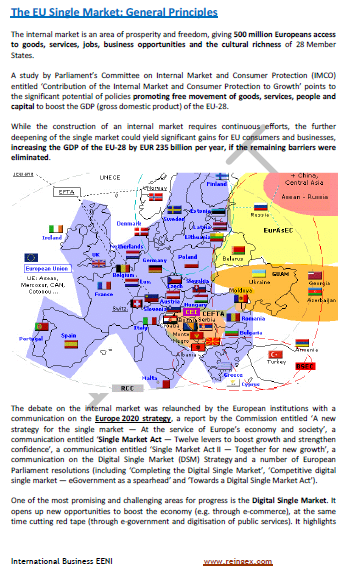

Language of the Program “adaptation of the Bachelor of Science to EU
students” of the Bachelor of Science in International Trade (second semester):  or or
or or  EENI
EENI  EENI
EENI  EENI.
EENI.
(c) EENI Global Business School (1995-2024)
We do not use cookies
Top of this page

